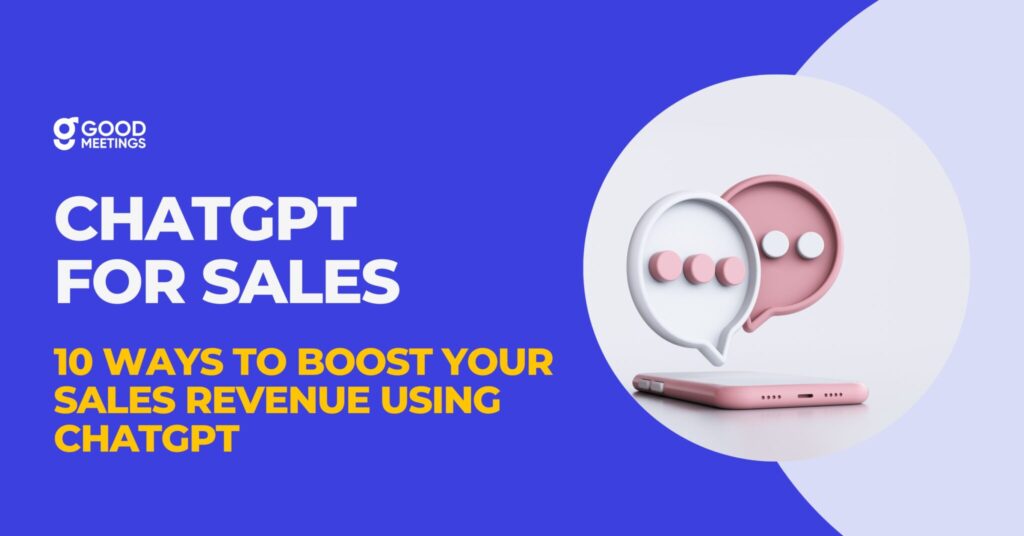In the world of sales, every conversation holds the potential to turn a prospect into a loyal customer.
These conversations go beyond merely presenting your product or service — they’re about how well you connect, understand, and respond to your prospect’s needs.
However, knowing how to properly conduct productive conversations is not as easy as it seems.
To help you out, we’ll explore how you can hold effective sales conversations that resonate, engage, and ultimately convert.
With the helpful strategies outlined in this blog post, you can easily make every sales interaction meaningful, build trust with your prospects, and boost your revenue.
What is a Sales Conversation and How Do You Start One?
A sales conversation is a dialogue between a salesperson and a prospect that aims to explore the customer’s needs, challenges, and goals & identify how a product or service can provide value to them.
It’s an interactive process that goes beyond mere pitching to engage the customer in a meaningful exchange of information.
This conversation seeks to build trust and rapport, uncover specific requirements or pain points, and guide the customer toward seeing the proposed solution as the best fit for their needs.
Before initiating a conversation, you need to start with thorough research on your prospect to personalize your approach.
Then, begin the conversation with an engaging question or statement that resonates with their business challenges.
Overall, the key is to make the interaction as natural and meaningful as possible. We’ll discuss how you can do this in the coming sections!
8 Critical Skills To Win Every Sales Conversations
Want to navigate your sales conversations with ease and effectiveness? These essential skills will allow you to do so:
- Active listening: This involves fully concentrating on the speaker, understanding their message, and responding thoughtfully. Active listening in sales allows you to grasp the prospect’s needs and concerns genuinely so you can provide tailored responses.
- Empathy: Being able to put yourself in your prospect’s shoes is a powerful skill. It allows you to gauge their emotional state and respond in a way that aligns with their feelings and perspectives. Empathy builds trust and rapport, key ingredients for moving any sale forward.
- Rapport building: This involves establishing a positive relationship with your prospect from the outset. It’s about finding common ground and creating a sense of trust and mutual respect, which is critical for open and honest communication.
- Adequate product knowledge: Having a deep understanding of your product or service is essential. It allows you to confidently discuss how your offering can meet the prospect’s specific needs and answer any questions they may have.
- Adaptability: The ability to adjust your approach based on the conversation flow and the prospect’s reactions. Adaptability means being flexible in your strategy and communication style to keep the dialogue productive.
- Clear communication: You should know how to articulate your ideas and the value of your offering clearly. Avoiding jargon and being concise helps the prospect understand the benefits of your solution without confusion.
- Confidence: Confidence in yourself and what you’re selling instills trust in the prospect. It’s about showing belief in your product’s value and your ability to help the prospect, without coming across as pushy.
- Proper objection handling: You should be able to gracefully handle any objections a prospect may have. This skill involves listening to the prospect’s concerns, understanding the underlying issues, and responding with information that alleviates those concerns.
Related: 4 Ways To Measure and Improve Sales Effectiveness
Best Practices To Improve Sales Conversations
Now, let’s discuss 11 best practices that will help you enhance the quality of your sales conversations and drive successful outcomes:
1. Prepare
Before picking up the phone or composing an email, you need to study and understand your prospect first.
Research their industry, company history, and potential challenges they face.
This background knowledge will inform your approach and help you personalize your conversation so it doesn’t come off as generic.
2. Build rapport first
Relationships are the foundation of effective sales, as prospects are more likely to buy from people they like.
Research shows that 40% of sales professionals believe establishing customer trust and rapport is essential to sales strategy.
So, you should start your conversations by establishing rapport — it creates a comfortable environment for a more open and honest dialogue.
For example, you can comment on a recent achievement of the company or find a common interest that can increase the prospect’s willingness to engage.
3. Ask good open-ended questions
Crafting & asking open-ended questions that encourage detailed responses is key to diving deeper into the prospect’s needs, motivations, and challenges.
These questions will prompt the prospect to think and reflect, providing you with insights that you may not get with simple yes-or-no answers.
For instance, you may ask questions like, “Can you tell me more about the challenges you’re facing with your current process?” or “What does the ideal solution look like for your team?”
4. Highlight value, not features
People buy solutions, not features. So, you should focus on how your product or service can solve the prospect’s specific problems or improve their situation.
For instance, rather than simply stating that your software has a high-speed processing feature, explain how this can allow your prospect to save time, improve team efficiency, and ultimately, increase their revenue.
5. Engage in active listening
By listening actively, you ensure that the dialogue is not one-sided but a balanced exchange of ideas and information.
This involves more than just hearing the words your prospect says; it’s about fully comprehending their message and responding thoughtfully.
Interestingly, statistics reveal that top performers in sales maintain a 46:54 talk-to-listen ratio, meaning they speak less than 50% of the time.
A balance like this gives the prospect ample room to express themselves, so you can better understand their perspective and tailor your pitch more effectively.
6. Leverage Artificial Intelligence (AI)
AI is fast impacting a lot of industries, and the sales industry is no different.
By taking advantage of the game-changing capabilities of AI tools, you can increase the quality of your sales conversations.
For example, check out what you can do with an AI-powered platform like Goodmeetings:
- Capture meeting details: Never miss a beat with high-quality call recordings, multi-language transcriptions, and human-level summaries. This ensures that you don’t miss out on any important detail & identify areas where you may need improvement.
- Automate processes: Access automated action items and integrate with CRM tools like HubSpot and Salesforce to reduce manual tasks.
- Prepare for your calls: Get instant access to client histories and key moments & make sure you’re fully prepped for every conversation.
- Enjoy in-call support: Leverage real-time AI guidance during calls that will help you communicate value propositions with more precision.
- Uncover insights: Understand what’s working and what’s not with important call insights.
- Access coaching: Refine your pitch & adjust your strategies with AI-driven and human coaching.
Supercharge Your Sales Conversations With Goodmeetings!
7. Keep the conversation human & natural
While it’s crucial to follow a structured approach (by using a sales script, for example), it’s equally important to maintain a human touch during the conversation.
Try to avoid sounding overly robotic, as this can create barriers to genuine connection. Always remember that at the other end of every sales conversation is a person with unique needs, concerns, and emotions.
So, strive to maintain a conversational and empathetic tone throughout your dialogue.
8. Establish trust
In any sales conversation, it’s important to gain the prospect’s trust.
Aside from presenting your product or service, you should demonstrate why your solution is the superior choice and why your company stands out from competitors.
Some great ways to establish trust during a conversation are by sharing success stories, providing solid data, and being transparent about your offering’s capabilities.
9. Control the flow and direction of your conversation
It’s also important to dictate how your sales conversations flow to ensure that they remain productive and aligned with your objectives.
This skill involves managing the pace, ensuring there’s a balanced exchange of information, and steering the conversation towards areas where you can highlight the value of your product or service.
Keep in mind that the top salespeople get customers to adjust their rate of speech by 13% on average, all within the first three minutes of the call.
10. Follow up effectively
44% of sales reps follow up with a prospect only once before giving up, and this shouldn’t be so.
This is because effective follow-up serves as the bridge between the initial conversation and closing the deal.
It’s not just about reminding your prospects of your existence; it involves reinforcing the value you offer, addressing any lingering questions or concerns, and keeping the momentum of the conversation going.
11. Continuously learn and adapt
Research shows that 66% of salespeople are regarded as being average or poor.
So, if you want to become a top-performing rep, you need to treat every sales conversation as a learning opportunity.
Reflect on what worked and what didn’t, and be open to adjusting your approach based on feedback and outcomes.
Use Goodmeetings‘ valuable meeting insights to analyze how well your conversations went and pinpoint areas for improvement.
Related: Sales Pipeline Management: The Ultimate Guide
Common Mistakes to Avoid in a Sales Conversation
Even the most seasoned sales professionals can sometimes find themselves stumbling in conversations with prospects.
Here are some common mistakes to watch out for during your conversations to increase your chances of success:
1. Interrupting the prospect
Jumping in while your prospect is speaking can come off as disrespectful and may suggest that you value your agenda and priorities over understanding their needs.
This behavior can quickly erode trust and rapport, which are essential components of successful sales interactions.
2. Overpromising
This involves making commitments or guarantees about your product or service that exceed its actual capabilities or what your company can realistically deliver.
This misstep often stems from a desire to impress the prospect and secure the sale by any means necessary.
However, overpromising sets unrealistic expectations, leading to disappointment, distrust, and potential damage to your reputation when you fail to meet those expectations.
3. Skipping the qualification process
Failing to qualify a prospect early in the conversation can lead to wasted time and resources on both sides.
The qualification process is essential for determining whether a prospect’s needs, budget, authority, and timeline align with what your product or service offers.
Without this crucial step, you risk engaging in lengthy discussions and presenting solutions that aren’t in line with the prospect’s needs and expectations.
Related: 10 B2B Sales Prospecting Tools in the Market
4. Asking too few (or too many) questions
Asking too few questions may signal a lack of interest or engagement with the prospect’s needs.
On the other hand, bombarding the prospect with an excessive number of questions can overwhelm them, making the conversation feel more like an interrogation than a two-way discussion.
If you want to foster a productive dialogue, you need to strike a balance.
Also, avoid asking your questions in a “checklist style.” Running through questions as if ticking boxes can make the conversation feel transactional and impersonal. Instead, weave your questions naturally into the dialogue, maintaining a conversational tone that invites open discussion.
6. Discussing price too soon
Doing this can be a bit hasty because it puts the spotlight on the cost before the prospect sees how valuable your product or service can be for them.
If you talk about price too early, the real benefits and special features of what you’re offering might not get the attention they deserve.
It’s better to first really dig into what the prospect needs and show them how your solution fits those needs perfectly.
This way, when you eventually talk about the price, they’ll understand it in terms of the value they’re getting, not just as a number.
7. Making assumptions about the real problem
It can be easy to jump to conclusions based on previous experiences or surface-level information, but every prospect’s situation is unique.
Remember that only the prospect can properly explain their pain points and specific needs, so avoid making assumptions.
8. Overwhelming the prospect with information
Avoid being so eager to showcase the value of your solution that you bombard your prospect with every detail, feature, and benefit.
It’s natural to want to share everything, but too much information can be overwhelming. Instead, focus on what’s most relevant to their needs and concerns.
9. Neglecting to establish next steps
Ending a sales conversation without clear next steps can stall the momentum of a potential deal.
So, whether it’s scheduling another meeting, a product demo, or a trial period, make sure both you and your prospect know what’s happening next.
In Conclusion
As you strive for sales excellence, remember that it’s the small adjustments that often lead to the most significant breakthroughs.
By embracing the strategies and insights shared in this guide, you’re not just committing to better sales conversations; you’re investing in deeper, more meaningful connections with your prospects.
Plus, by having an AI-powered tool like Goodmeetings in your arsenal, you can effortlessly refine all your conversations, making them as meaningful as ever.
GET IN TOUCH





